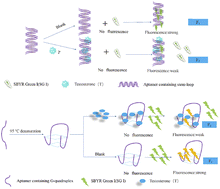A label-free fluorescent aptamer sensor for testosterone based on SYBR Green I
Abstract
Testosterone is a steroid hormone that plays an indispensable role in the normal metabolism of organisms. However, exogenous testosterone, even as low as nmol L−1, will harm the human body due to accumulation. In this study, we developed an unlabeled fluorescent sensor for testosterone based on SYBR Green I. SYBR Green I is a fluorescent dye that can be embedded into the G-quadruplex of the testosterone aptamer T5. The fluorescence quenching effect is utilized to achieve quantitative detection, which occurs by the competition between testosterone and SYBR Green I for the T5 aptamer binding sites. In this work, we optimized the detection conditions to make the fluorescent sensor more sensitive and verify the specificity, linear range, and detection ability in the buffer and real water samples. The sensor's LOD and LOQ values were 0.27 nmol L−1 and 0.91 nmol L−1, respectively, while the detection range was linear from 0.91 nmol L−1 to 2000 nmol L−1. According to the results, the sensor shows high specificity and good performance even in real sample detection such as tap water and river water, providing an alternative method for the quantitative detection of testosterone in the environment, which is more convenient and efficient.



 Please wait while we load your content...
Please wait while we load your content...